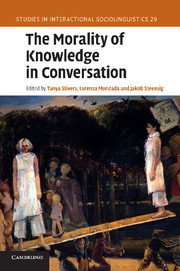Book contents
- Frontmatter
- Contents
- Contributors
- Preface
- Acknowledgements
- List of transcription and glossing symbols
- Part I Introduction
- Part II Affiliational consequences of managing epistemic asymmetries
- 2 The management of knowledge discrepancies and of epistemic changes in institutional interactions
- 3 Claiming epistemic primacy: yo-marked assessments in Japanese
- 4 Morality and question design: “of course” as contesting a presupposition of askability
- 5 Addressing epistemic incongruence in question–answer sequences through the use of epistemic adverbs
- 6 The epistemics of make-believe
- Part III Epistemic resources for managing affi liation and alignment
- Part IV Toward a framework
- References
- Index
6 - The epistemics of make-believe
Published online by Cambridge University Press: 05 November 2011
- Frontmatter
- Contents
- Contributors
- Preface
- Acknowledgements
- List of transcription and glossing symbols
- Part I Introduction
- Part II Affiliational consequences of managing epistemic asymmetries
- 2 The management of knowledge discrepancies and of epistemic changes in institutional interactions
- 3 Claiming epistemic primacy: yo-marked assessments in Japanese
- 4 Morality and question design: “of course” as contesting a presupposition of askability
- 5 Addressing epistemic incongruence in question–answer sequences through the use of epistemic adverbs
- 6 The epistemics of make-believe
- Part III Epistemic resources for managing affi liation and alignment
- Part IV Toward a framework
- References
- Index
Summary
Introduction
Between the ages of three and five or thereabouts, children engage in a form of imaginative play that involves a transformation of ordinary objects and persons into characters in a fictional world. Such “make-believe” or “pretend-play” has long been of interest to scholars of child development, and a number of theories concerning the role it plays in the child's moral and cognitive maturation have been advanced. Considerably less attention has been paid to the actual structures and practices associated with the activities of make-believe. This is unfortunate given the obvious importance that these play in the everyday lives of children. In an attempt to redress this situation, in this chapter I treat make-believe as a form of social interaction and attempt to describe some of its basic features. As in any other form of social interaction, participants in make-believe orient to it as a normatively organized set of practices – one practice can make another expectable or “conditionally relevant” (see Schegloff 1968, 2007b), and if that second action is not done it can be found absent by the participants.
I will show that epistemic rights to talk about make-believe characters and events flow from participation in the activity. In activities that are essentially sole ventures, imaginative transformation is accomplished unproblematically by the use of bald assertions (e.g. “It's a Rubik's cube”). At the other end of the scale, a child who talks about a character being animated by another participant typically uses an interrogative format to do this (e.g. “Do they say you can't hide from me?”).
- Type
- Chapter
- Information
- The Morality of Knowledge in Conversation , pp. 131 - 156Publisher: Cambridge University PressPrint publication year: 2011
- 30
- Cited by



